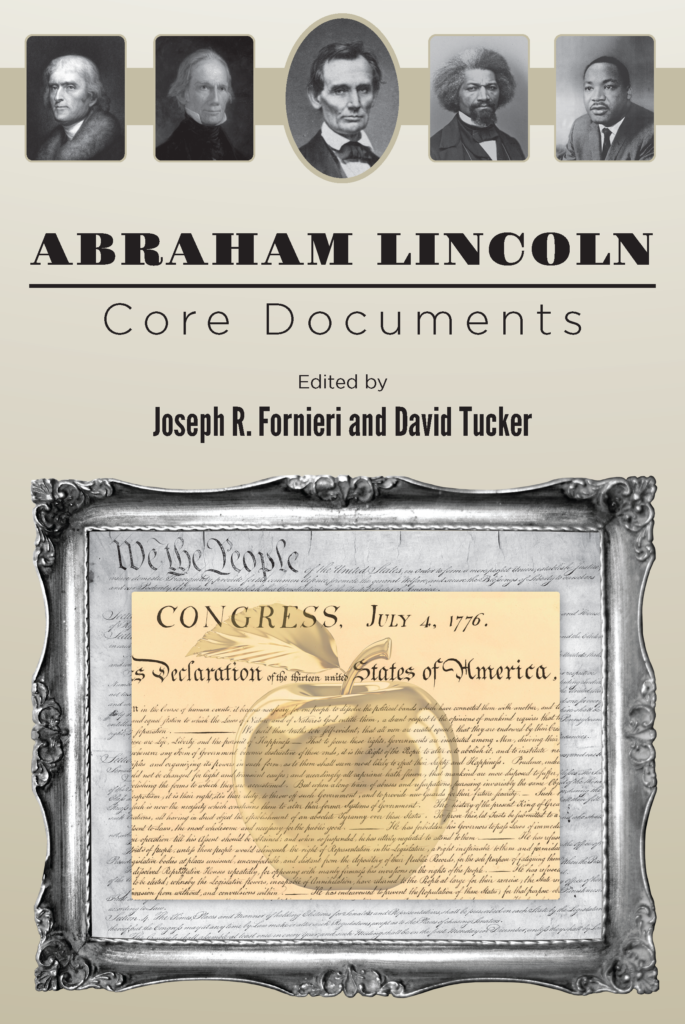Lincoln's Apple of Gold
January 25, 2023

The image featured on the cover of Ashbrook’s new Core Documents volume, Abraham Lincoln, might puzzle the casual observer. Why a golden apple in a silver frame? Looking closer, you might ask why this apple is superimposed on words from the Declaration of Independence—and why the silver frame is inscribed with words from the Preamble to the Constitution?

Show this image to any student or teacher who’s studied Abraham Lincoln in Ashbrook programs, and you’ll get an immediate explanation—“That’s the apple of gold in the frame of silver,” they’ll say. They’ll explain that Lincoln used this image in a private note to himself, the “Fragment on the Constitution and Union,” in which he spelled out his understanding of the relationship between the central principle of the Declaration of Independence and the purpose of the nation that came into being when thirteen newly independent states signed the Declaration. They’ll also say that Lincoln used the analogy to explain how to properly understand the Constitution: that it was a framework of government designed to perpetuate the principle of “Liberty to all” contained in the Declaration.
An Analogy Teachers Recognize
During a recent summer session of Ashbrook’s Master of Arts in American History and Government graduate degree program, three teachers from three different regions of the country—Shannan R. of Texas; Lauren G. of New York; and David W. of Pennsylvania—talked with an Ashbrook staff member about the documents they’d studied. They spoke of how those documents had helped them and their students better understand our nation’s history. Talking together during a time when they noticed a dearth of civility in public political discussions, they noted that the documents also gave them hope for our nation’s future. A few minutes into this conversation, one of the teachers alluded to Lincoln’s Fragment on the Constitution and Union.
Ashbrook: When your students discuss what it means to be American, do they begin to feel confident that they have a voice in our politics—that what they do and say as citizens can make a difference?
Shannan R.: I hope for that. But at the moment, they are watching adults not behaving like adults should when discussing government and politics. It discourages them. We grew up in a generation where this stuff wasn’t happening; our students haven’t seen enough sunrises and sunsets to know the cycle changes. But I have hope because I listen to my students’ point of view. I hear them saying, “This is isn’t how we want it to be. We have the power to change it. . .
Lauren G.: I’m an optimist; I always have that hope. I always theme my class around the question, “Are we living up to the ideals that were put forward in the Declaration? Are we building on those ideals? If so, how are we doing that?” As we discuss the issues in our past, sometimes students feel we are making progress, and sometimes they feel we’re not there yet. When they say, “not yet,” I ask, “How can we do better? How can we achieve that ‘golden apple’?”
Ashbrook: The “golden apple in the frame of silver.” Do all of you use that image in your classrooms? That image from the Bible, Proverbs 25:11—“A word fitly spoken is like an apple of gold in a frame of silver”—that Lincoln quoted and applied to the American Founding? [Everyone nods.] One teacher I know asked a student artist to paint a picture of this idea that he could hang in his classroom, so that during classroom discussion, he could point to it and ask students how it informed the historical issue they were discussing. Did you all know this fragment of Lincoln’s before you started the program?
Shannon R.: I did not.
Lauren G.: No.
David W.: No. Dr. Dan Monroe introduced that to me.
Lauren G.: . . . My exposure to these documents through Ashbrook programs has meant my students are now exposed to these documents. Had I not known about the apple of gold in the frame of silver, they would never have known about it.
Ashbrook: So, is Lincoln saying: The Constitution is like a frame of silver around the apple of gold, which is . . . ?
Lauren G.: The Declaration.
Teacher Roundtable, July 2021
There is a reason why so many teachers in Ashbrook programs find the Fragment on the Constitution and Union one of the most important documents they teach. It gives them and their students a way of making sense of the somewhat contradictory story of our Founding and There is a reason why so many teachers in Ashbrook programs find the Fragment on the Constitution and Union one of the most important documents they teach. It gives them and their students a way of making sense of the somewhat contradictory story of our Founding and subsequent development as a nation.



The Constitutional Crisis Lincoln Confronted
At the time Lincoln wrote the fragment, he was struggling with a Constitutional crisis. Most likely he wrote this note to himself prior to his first inauguration, while musing over a letter he’d received from Alexander Stephens, who was soon to be elected Vice President of the Confederacy. Stephens had already resigned from Congress in order to throw his lot in with the secessionists; yet he urged Lincoln to defuse the situation he and other Confederates were inflaming. Could not Lincoln speak a few calming words prior to his inauguration as President? “A word fitly spoken by you now would be like ‘apples of gold in pictures of silver,” Stephens urged.
Stephens implied that what was needed from the incoming president were reassurances that his administration would not threaten the South’s slave labor system. Lincoln mildly replied: “Do the people of the South really entertain fears that a Republican administration would, directly, or indirectly, interfere with their slaves . . . ? I wish to assure you . . . that there is no cause for such fears.” Then Lincoln pointed out the real issue dividing South and North: “You think slavery is right and ought to be extended; while we think it is wrong and ought to be restricted. That . . . certainly is the only substantial difference between us.” This was the position Lincoln, who did hope to avoid war, and who also saw himself as bound by Constitutional restrictions from acting to dismantle the slave system, steadily maintained as he campaigned and as he entered presidential office.
How Lincoln Viewed the Declaration
Privately, however, Lincoln spelled out another difference between himself and Stephens. He assigned an entirely different meaning to the “word fitly spoken.” The most important commitment the nation ever made was to the principle embedded in the Declaration, that “all men are created equal.” As Lincoln put it, the Declaration was animated by the principle of “Liberty to all”. Whereas Stephens would soon declare in his own inaugural speech that these words were a manifest lie, Lincoln saw them as the principle the Constitution was written to frame and protect:
The expression of that principle, in our Declaration of Independence, was most happy, and fortunate. Without this, as well as with it, we could have declared our independence of Great Britain; but without it, we could not, I think, have secured our free government, and consequent prosperity. No oppressed people will fight, and endure, as our fathers did, without the promise of something better, than a mere change of masters.
The assertion of that principle, at that time, was the word, “fitly spoken” which has proved an “apple of gold” to us. The Union, and the Constitution, are the picture of silver, subsequently framed around it. The picture was made, not to conceal, or destroy the apple; but to adorn, and preserve it. The picture was made for the apple — not the apple for the picture.
Lincoln makes another Biblical allusion that Stephens did not—to Jesus’ teaching on the Sabbath, when he was accused of violating Sabbath law. Humankind was not created to serve Sabbath regulations, Jesus replied; rather, a day of rest was set aside for the health of humankind. The law itself allowed a farmer to break the rule of Sabbath rest to pull an ox out of a ditch into which it had fallen. Just as the law allowed the farmer to preserve the life and health of his ox, so did it, properly understood, allow Jesus to heal a man with a withered arm or forage food for himself and his hungry disciples on the Sabbath. Exactly in that way should the Constitution be understood, Lincoln implies. Its various provisions—even those that seemed to contradict the principle of “Liberty to all”—were hammered together so as to allow the principle to survive the expediencies of political life, in which compromises had at times to be made. The Founders had granted concessions to Southern slaveholders to keep their fledgling government from dissolving and dying before it became securely established.
Lincoln’s Deeper Purpose
But some Americans, especially a number in the South, had abandoned any sense of the centrality of the Declaration to our system of government. They maintained that the Constitution had been written to legitimize the use of slave labor. Lincoln admitted that the Constitution implicitly acknowledged slavery, through the three-fifths clause and the fugitive slave recovery provisions; but he denied that it ever explicitly supported the idea that there could be property in human beings. The provisions of the Constitution pointed to by the defenders of slavery used vague references to “all other persons” and “persons held to service or labor.” Nowhere in the Constitution could one find the word “slave” or “slavery.” Lincoln saw the Founders’ careful wording as designed to make room for the eventual disappearance of slavery.
One may well conclude that, in understanding that Lincoln wanted to set in motion a process to end slavery—even if only gradually—those who promoted secession were not wrong to fear Lincoln would cause the end of their peculiar institution. There was nothing he could have honestly said to allay such fears. Still, he strove to preserve the union first of all, believing that the principle of equal liberty for all would not survive the dissolution of the only government yet dedicated to that principle.
Some students and teachers, reading Lincoln’s exchange of letters with Alexander Stephens, may see him as splitting hairs. Others may judge him more harshly, seeing him as compromising his commitment to “Liberty to all”. Yet teachers in Ashbrook programs who read the letters alongside the Fragment on the Constitution and Union usually conclude Lincoln pursued a deeper purpose. They teach the fragment to help students understand our country’s bumpy road toward the realization of its Founding principles.

